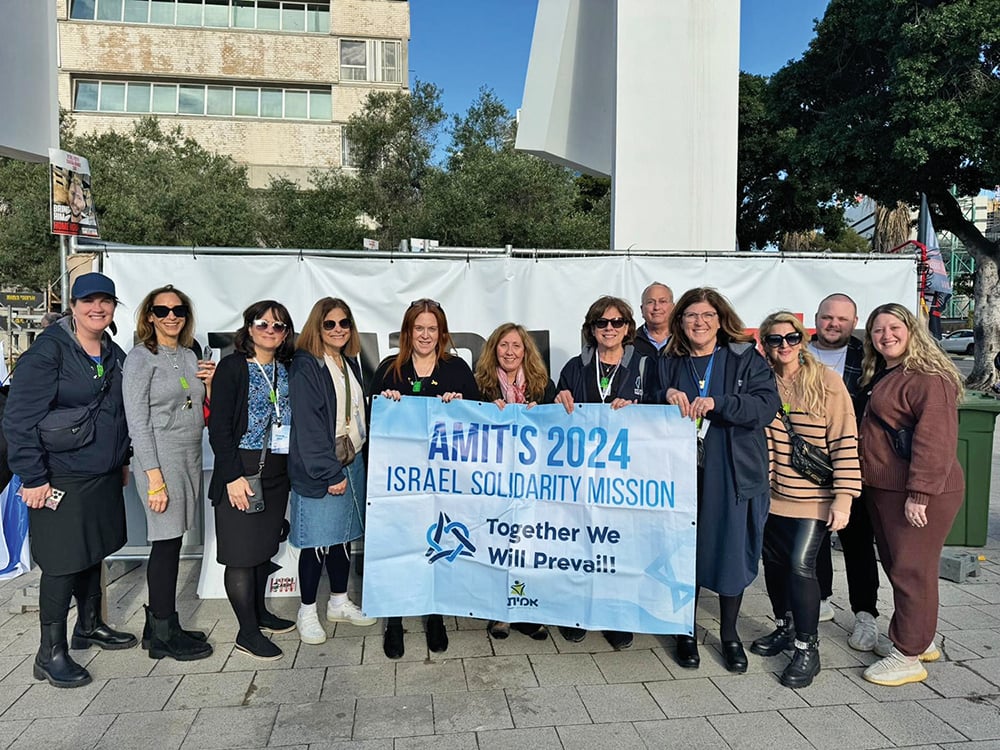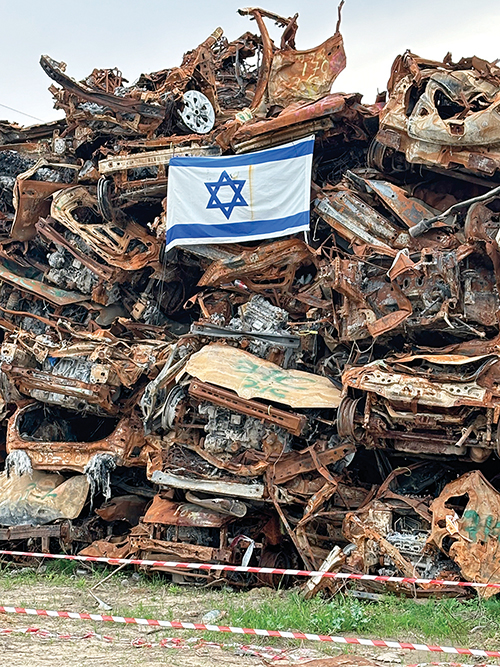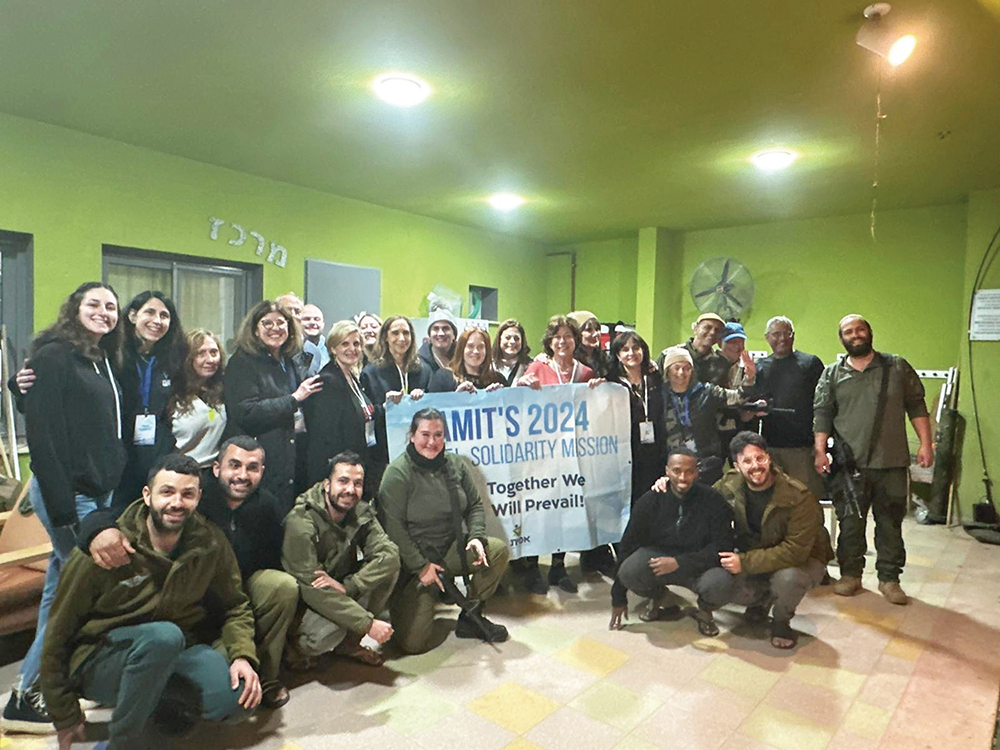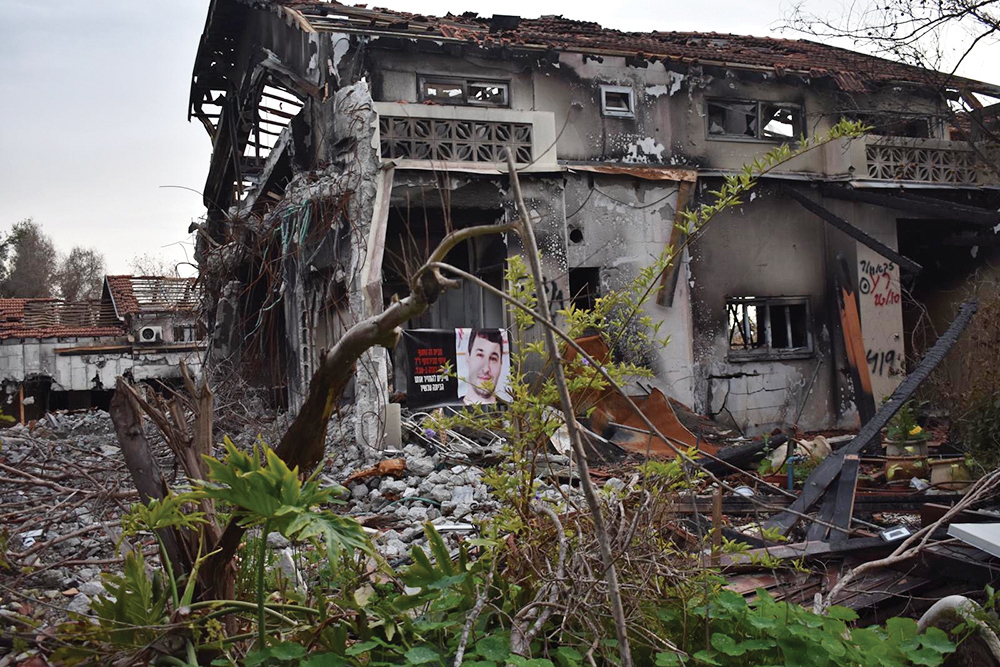
I have been wearing the Blue and White paper bracelet that I received at the November 14 March for Solidarity in support of Israel after the October 7 massacre, the freeing of the chatufim (hostages) and against antisemitism.
It was most fitting to wear my bracelet, now tattered and torn, on the AMIT Swords of Iron Solidarity Mission this past month. I wanted to visit to offer words of support, hugs to both family and fellow Jews, and to return to the States to bear witness to the unspeakable atrocities that had occurred. Little did I dream that it would be I who would return devastated but truly restored and enriched as the recipient and not source of the unexpected outpouring of gratitude that I received from the minute I began my journey.
Seated aboard the Israel bound El Al plane, I explained to the flight attendants the meaning and symbolism of my bracelet. They were so moved that one flight attendant immediately removed the yellow pin signifying support for the return of the hostages from her sweater and affixed it to mine. A second went in search of the ubiquitous necklace that resembles dog tags to present to me in gratitude.
Thus began our profound and sensitively navigated four-day journey that would transform everyone present: The words surreal, dichotomy, juxtaposition, disequilibrium, heroism, horror, humility, barbarism and selflessness would slip in and out of conversations and my consciousness time and time again.
AMIT, a reshet or network of over 87 schools in 29 cities, serves a population of approximately 44,000 children and teens all over Israel. Their schools range from Noga, in Bet Shemesh, an impressive high school where girls are taught high-level academics as well as Talmud, to Amit Frish Beit HaYeled, a residential facility where children who have been removed from their homes due to family crises are placed in mishpachtonim, or family-style apartments. What distinguishes AMIT’s models from all others is that each mishpachton is led by a married couple to enable children to experience positive role models to emulate when they become adults.

AMIT, like many other organizations, had to pivot after the war. They created schools from scratch in places like the Dead Sea to accommodate the thousands of displaced children from the south, such as Sderot, our first stop on the mission. But in every single school we visited, we were impressed by the selflessness, dedication and devotion to each student and their needs that every administrator and teacher displayed. Several students shared their harrowing wartime experiences. Yet, they were so grateful to us for coming and for supporting AMIT.
Having last visited the city of Sderot 50 years ago, I couldn’t believe the huge city it had become. Standing in a commercial shopping center reminded me of our local Scarsdale shopping center, one that was recently defaced with antisemitic/anti-Zionist graffiti. A few weeks ago I participated in a rally there. Yet, in New York the red paint was washed away within hours, leaving our shopping center intact and viable; albeit, with an unsettled, discomforting feeling. Nothing compared to what we saw in Sderot. The shopping center was mostly empty, boarded up and riddled with bullet holes from the Gazan terrorists who emerged just over the bridge to enter the center. It was unexpectedly uplifting to watch a worker carefully planting new trees amidst the parking lanes. Optimism and stoicism amidst and despite disaster.
In nearby residential Sderot, hideously missing like a knocked-out front tooth, was the former police station, which had been intentionally bulldozed by the Israelis, leaving an empty lot. It was there that eight policemen, led by a heroic woman, lost their lives trying to stave off the onslaught of Gazan terrorists who stormed the city the morning of October 7. Painted on an adjacent wall was a beautiful and poignant mural depicting the city in flames with a giant sefer Torah atop the former police station. Symbolically, its Hebrew letters turned from black to white and pure, gently floating up to heaven before they disintegrated to black dust. In total more than 50 residents and 20 police officers were massacred.
As a former kindergarten morah, perhaps most wrenching to me was the playground, where a giant, colorfully painted caterpillar snaked through the swings and slides. It serves as a bomb shelter and was intentionally designed to be perceived as less threatening for the children who would need to run and seek shelter within seconds for protection from the never-ending bombs and rockets from Gaza. The AMIT school stood empty, as did most of the rest of the city. Later, we stood on a grassy promenade overlooking the city of Gaza a mere two miles away, with explosions lightly punctuating our guide’s words.

At Rahat, we met an Arab man who shared that on October 7 he was driving his wife, an Israeli Arab, to work with their infant child when they were attacked by Hamas terrorists, who didn’t care that they, too, were Arab. His wife was shot and died immediately. He escaped with the infant; after hiding for four hours with his crying baby, they were miraculously saved by an Israeli soldier. He survives to raise nine children single-handed. As the widower of an Israeli Arab wife, he receives financial and material support from the Israeli government. Upon our return to the States, We were thrilled to learn that he had recently been granted Israeli citizenship. Lesson learned: The terrorists did not discriminate in terms of whom they murdered, butchered or kidnapped.
We then traveled to the Tekuma parking lot—a football stadium-sized testament to the hundreds of mostly young men and women attending the Nova music festival who had unsuccessfully attempted to escape, first by foot and then by car. There, stacked by the dozens, lay the rusted, bullet-ridden vehicles. My first reaction was that I was walking through Yad Vashem, and the mountains of eyeglasses and shoes had been transformed into various means of transportation.
Most moving was the occasional car that was intentionally left exposed in the middle of the field. The exterior of these cars appeared smashed, damaged and destroyed. Yet, a peek inside revealed the contents of what was once young adults on a road trip to enjoy a good time and attend a concert—pillows, blankets and random paraphernalia that one would take on a car ride. A cruel juxtaposition of life abruptly and cruelly interrupted.
Our bus then drove on the newly named “Death Road,” from which most of the salvaged cars were transported from the grounds of the Nova festival. Gently swaying in the breeze were photos of the innocent young people who had been brutally, viciously slaughtered that day. Kalaniyot (red anemones), Israel’s national flower, had started to bloom.

The final descent into “living hell” and a modern-day Auschwitz was our visit to Be’eri, one of 22 kibbutzim where over 100 souls, including the elderly and infants, were brutally butchered, burnt alive and slaughtered. It was here that I/we experienced cognitive dissonance from which I am trying to reconcile more than a week later.
At first sight, the kibbutz appeared to be almost a Gan Eden, a paradise of beautiful homes, foliage and a clear blue sky above. The first portent that something was amiss occurred when, in addition to hearing the sweet songs of birds that is so common, we heard the raw, irritating caw of crows … something was definitely awry. Suddenly, the devastation, burnt homes, charred trees, overturned furniture and already sanitized remains of inconceivable destruction assaulted us.
On the morning of October 7, Be’eri was overrun first by Hamas terrorists who killed, maimed, burned, raped, butchered, beheaded and dismembered more than 100 of its inhabitants. Even more horrifying is that they were followed by two additional waves of Gazan citizens, many of whom were friends of the Be’eri residents, who then plundered the homes and performed more unspeakable acts of violence against the residents. Later, each home was painstakingly dissected and examined by Israeli soldiers looking for bodies, body parts and additional evidence of what took place. The various signs and symbols painted on the outdoor walls of each home represented what had been found and that the search had been completed.
Our guide explained that the mamad or bomb shelter was designed for exactly that—protection from bombs, not terrorists. The interior doors to the mamad do not even contain locks. So, when the residents fled to the “safe rooms,” they were virtually imprisoned as sitting ducks. In one case, a father, promising to report to army duty, heroically defended the door while his wife and two young children escaped through the mamad window. Sadly, he did not survive.
Among the most disturbing visits was a tour through the remnants of the home of Vivian Silver, a 74-year-old Canadian-Israeli widow and peace activist (who coincidentally went to school with a dear friend of ours). She spent three days a week traveling to Gaza to bring ailing Arab children back to Israeli hospitals for care and medical attention. Upon entering the blackened and soot-ridden remnants of her once-sturdy home, we could not even stand straight as we teetered over the broken shards of ceramic tiles that must have once served as the roof. A perfect analogy of what we were physically and mentally experiencing. The house was a burnt carcass of appliances, half-broken walls and household items. Finally, we stood inside the infamous mamad.

Maya explained that at first, Silver, ob’m, was thought to have been among the kidnapped hostages. However, after a month, it was determined that amidst the approximately foot of dust and ash, were the remains of this blessed woman, who now could be identified only by her DNA.
A final, haunting image that I will never forget is the sight of a child’s Teva sandal amidst the grass. Only one. Mystically, I could almost see the image of the child associated with the shoe. Was he/she running away/to/from safety? So innocent. So cruel. So inhumane. So resonant of the Shoes on the Danube River bank memorial in Budapest where Jews were shot or jumped to their deaths during the first Shoah.
As we left, my husband, Josh, led the group reciting Tehillim. I do hope and pray: Never again!
As the sun set into a deep, inky, eerie darkness in the Israeli envelope that echoed our feelings, we all headed to the Re’im Army Base for a barbecue with Israeli soldiers. Rarely at a loss for words, during our debriefing I remained silent as I was experiencing physical, wrenching pain from what I had just witnessed, afraid that if I did speak, I would break down in tears.
After a few awkward moments, we approached the reservists stationed at this former, now evacuated kibbutz. And then, the miracle of the Jewish people—achdut—unity—am echad, lev echad, started to unfold. These beautiful young men and women were so open, engaging and like every other Israeli we encountered, grateful to us for coming to visit them! They were immensely proud to be serving and were eager to “finish the job.” A volunteer band began to play. Their music became the balm to many a seared soul. After dinner we danced with these inspiring soldiers and spontaneously serenaded them in song after song. I cry happy tears as I recount this event.
Within a few hours the shards of my body, mind and heart went from the lowest of the low and started to mend and experience the stirrings of the highest of the highest.
Am Yisrael Chai!
An equally powerful experience that will be forever ingrained in my mind is our visit to the Tel HaShomer Rehabilitation Center in Tel Aviv. We were greeted by a true lamed -vavnick and brother to one of our amazing AMIT guides. Originally designed primarily as a geriatric rehabilitation center, it quickly pivoted to service the many hundreds of soldiers who returned from Gaza physically incapacitated.
We were instructed Not to take photos and to traverse quietly and politely through the halls. Stepping outside to a patio I set my eyes on perhaps one of the most strikingly handsome young men I have ever encountered, with piercing, crystal blue eyes that seemed to sear my soul (yes, sounds like a corny romance novel), thick dark hair and a stunning smile. My eyes dropped a bit to see long, exceedingly muscular shoulders and arms. As my eyes drifted down a bit more, I saw him seated in his wheelchair and it was obvious that one leg was missing at the hip joint. Beside him were his mother and family. I bit my lip and tried to smile. Someone from our group handed him adorable get- well cards drawn by her students back in the States. And again, that dazzling smile. We explained our reason for visiting and once again, HE THANKED US FOR COMING. We had the privilege of speaking with several young men that day. Each story was more remarkable and heroic than the next.
As we were leaving, we met another handsome young man loping in. He shared how he was the company commander when they were all attacked. Several men died immediately, but one seriously injured soldier asked him not to leave his side. Despite being severely injured himself, he tied a tourniquet around the wounded soldier and remained with him until another medic insisted he himself be treated- his leg had been ravaged by shrapnel from his hip to his ankle. He showed us the horrible scars and recounted the many surgeries that have enabled him to walk again. He considers himself exceedingly fortunate and is eager to be fit enough to return to battle to “finish the job.” When we all thanked him for his heroism in saving his soldier, without missing a beat, he insisted, it was not he who saved his fellow soldier, but it was WE/US/OUR UNIT who saved him. It is that story and the many other incredible bits of courage, heroism, selflessness, determination and dedication to our people that enable me to leave feeling more hopeful and confident than ever.
From the dead, to the wounded, to the missing.
Kikar Chatufim
Located on the plaza in front of the Tel Aviv Museum is Kikar Chatufim, Hostage Square. It seems it has evolved into the epicenter and heart of the city, and perhaps even the whole country. for those family members and friends who do not want to forget the remaining captives, and for those who want to reach out and provide comfort and solace in this indescribably difficult situation. It is the magnet for fellow Israelis, or volunteers like us who have come from abroad, to offer support and even hugs.
A giant stadium-sized scoreboard greets each visitor; it systematically ticks off in red the number of days, hours, minutes and seconds the hostages have been missing. A very long Shabbat table set for 234 people (representing the original number of hostages), surrounded by empty chairs, bisects the plaza. This concept has been emulated in Jewish communities around the world, including White Plains, my hometown, where I joined perhaps 200 other people on an Erev Shabbat a few months ago to say Tehillim and symbolically usher in a Shabbat that was denied to hostages while in captivity. In Hostage Square, a section of this Israeli table has been reset with moldy pita bread and dirty water bottles to reflect the living conditions that those who have thankfully been released from captivity have described.
Also situated centrally in the plaza is another life-size snake (reminding me of the bomb shelters at Sderot). This one is straight and covered in messages, photos and illustrations created by visitors. This “snake” was designed to emulate the underground tunnels used by Hamas to enter Israel and transport and imprison Israeli captives. As a certified claustrophobic, I was very anxious about entering the more than 90-foot structure. With a deep breath, I stepped in, hoping not to hyperventilate. But, in my case I knew there was a way out. I can only imagine what the hostages endured and continue to endure.
Surrounding the plaza are various tents, or open-air clusters, where family members of the hostages sit in chairs, usually beside posters of their loved ones. Again, with apprehension, many of us approached these people with trepidation. After hearing their stories, we once again became connected. After speaking with two men from the same kibbutz, I showed them my now even more frazzled bracelet and explained what it was. The man who had been silent during our entire conversation suddenly leaned in and gently took my hand and thanked me, once again reducing me to tears.
And so my story and bracelet have come full circle. I have embarked on a profound journey, similar to so many others, that has exposed me to the horrors and heroism, destruction and rebuilding, devastation and renewal, pain and joy, and pure stoicism, courage, selflessness, steadfastness and hope that is enabling Israel to move forward. The enormity of gratitude and appreciation that I received from each and every individual I encountered, from the flight attendants to the students from AMIT, soldiers at the barbecue and rehabilitation center and hostage family members so surpassed whatever solace I had hoped to offer, it’s unimaginable.
As of this writing my blue bracelet is truly in tatters and I expect it to fall off shortly, but I am grateful for the opening it provided me to reach out to everyone I met.
I proudly wear the yellow ribbon pin given to me by the stewardess on the plane and the dog tags given to me by a grateful Tel Aviv resident, which remind me on a daily basis what I need and will continue to do—speak out on behalf of the hostages and the Jewish State of Israel and all for which it stands. For those of you who have been reticent about going, please rethink. You will be rewarded and enriched time and time again by the gratitude and appreciation of our fellow Jews who have experienced such an overwhelming tragedy.
Am Yisrael Chai!
A Jewish educator for over four decades, “Morah Jane” taught kindergarten at Westchester Day School for almost 25 years. She also served as the principal of the Hebrew Institute of White Plains religious school for many years. A graduate of Barnard College, she earned a master’s degree in early childhood and gifted and talented. Longtime active member of the Hebrew Institute of White Plains, New York. Married to Josh Grauer, she is a proud bubbie of six grandchildren.









